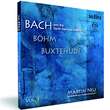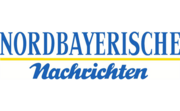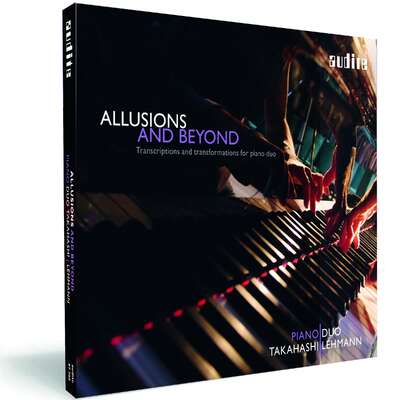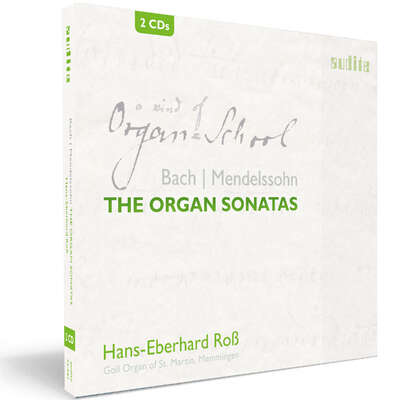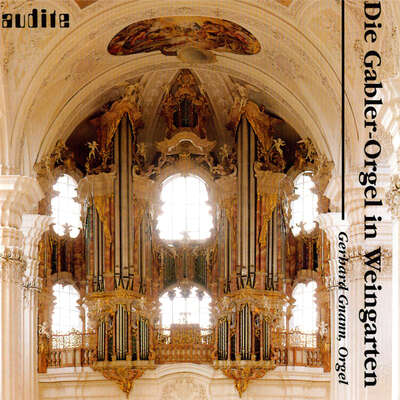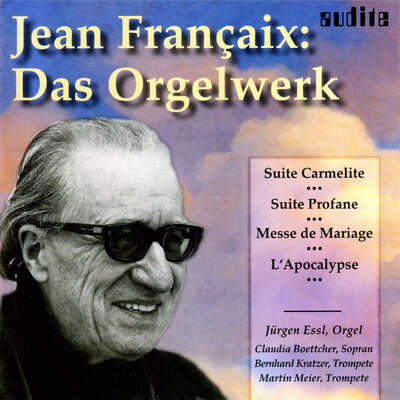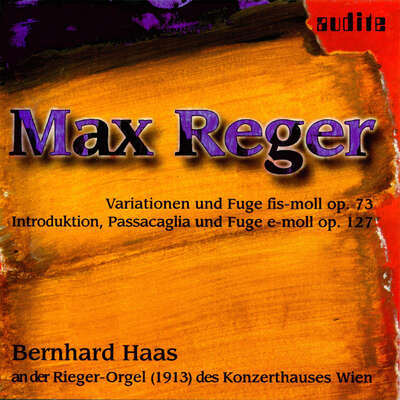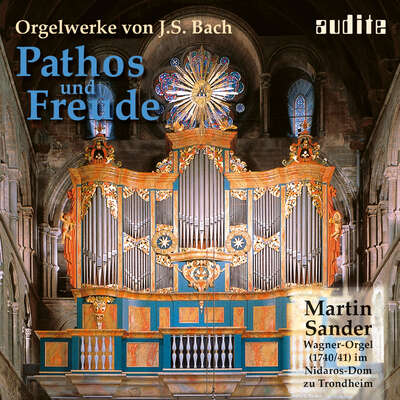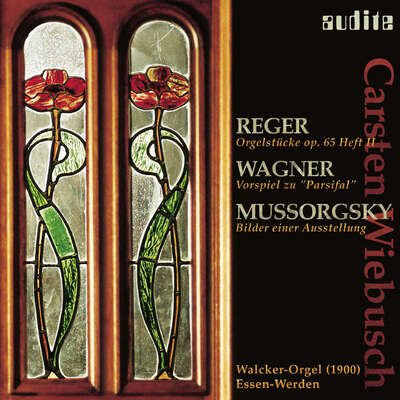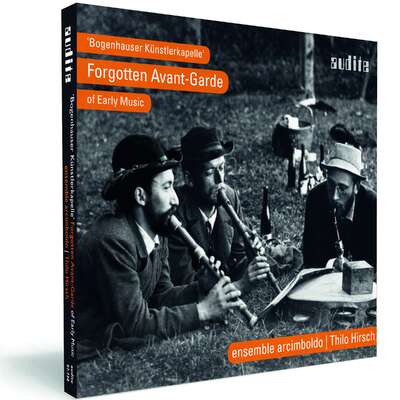
Two North German musicians considerably influenced the young JS Bach: Georg Böhm and Dieterich Buxtehude. This recording demonstrates the delightful musical relationship between Bach and his predecessors. Martin Neu brings this relationship to life on the new Ahrend organ in Herzogenaurach.more
"Martin Neu hat auf einem modernen Instrument Beispiele der Vorbilder und Bachs erhellend einander gegenübergestellt; demnächst soll ein Album zur süddeutschen Tradition folgen." (Falter)
Details
| Bach and the North German Tradition Vol. I | |
| article number: | 92.547 |
|---|---|
| EAN barcode: | 4022143925473 |
| price group: | ACX |
| release date: | 19. February 2010 |
| total time: | 72 min. |
Reviews
Fono Forum | Mai 2012 | Friedrich Sprondel | May 1, 2012
Wege zu Bach
Bach nahm so viele Einflüsse in seine Orgelmusik auf, dass sich einem neugierigen Interpreten viele Wege zu ihm auftun – und manche Aufnahme zeigt, dass auch noch neue zu begehen sind.
Die Britin Margaret Philips bringt ihre Bach-Gesamteinspielung in Doppelfolgen heraus; jede Scheibe ist dabei einem prominenten Instrument gewidmet.Mehr lesen
Das kann auch für den Leipziger Thomasorganist Ullrich Böhme gelten. Zuletzt hat er sich die großen Orgelchoräle vorgenommen, die Bach in seinen späten Leipziger Jahren in einer Sammelhandschrift zusammenfasste. Jedem Choral stellt Böhme einen Bach'schen Choralsatz voran, gespielt auf der kleinen Hildebrandt-Orgel von 1723 in Störmthal, einem kraftvoll-herben Instrument, das Bach bekannt war. Den jeweiligen Orgelchoral – oder die zugehörige Werkgruppe – spielt Böhme dann auf der großen "Bachorgel" der Leipziger Thomaskirche, die Gerald Woehl im Bachjahr 2000 fertigstellte. Beide Instrumente wurden mit vorteilhafter Direktheit aufgenommen und die farbenreiche, klangmächtige neue Orgel kann neben der charakterstarken alten gut bestehen. Ein Vergnügen aber ist, zu erleben, wie die "Bachorgel" den Thomasorganisten offenbar inspiriert. Er artikuliert und registriert, bei straffen Tempi und absoluter Klarheit, mit umwerfender Spielfreude. Die höchst anspruchsvolle Sammlung wird in ihrem stilistischen Reichtum unmittelbar erlebbar: als packende Musik.
Martin Neu möchte in seinen beiden Einspielungen Bach aus der Perspektive der nord- und süddeutschen Orgelkunst des 17. Jahrhunderts sichtbar machen. Er hat sich stilistisch adäquate Instrumente ausgesucht: Die Ahrend-Orgel in Herzogenaurach überzeugt mit warm-artikuliertem Klang und gibt dem norddeutschen Repertoire – hier beschränkt auf Bachs unmittelbare Bekanntschaften Böhm und Buxtehude – lebhafte Farbigkeit; beim süddeutschen – Kerll, Muffat, Froberger und Pachelbel – nutzt Neu die intensiv strahlende Metzler-Orgel in Obertürkheim für Pedaliter-Kompositionen, die Bernauer-Orgel in Laufenburg von 1776 mit ihrem satt-obertönigen Klang für die Manualiter-Musik. Hörbar inspiriert vom lebendigen Klang der Instrumente, spielt Neu stilistisch angemessen, übertreibt weder Tempi noch Artikulation und registriert oft betont schlicht, aber dank charaktervoller Einzelstimmen musikalisch sehr ergiebig. Die suggerierte Abhängigkeit begründet Neu im Booklet-Text einleuchtend; doch wird vor allem deutlich, wie stark Bach das Aufgenommene jeweils um- und sich anverwandelte.
Carsten Wiebusch geht einen Schritt weiter, indem er sich vornimmt, Bach gleichsam durch die Ohren eines anderen zu präsentieren: Er hält sich an die Ausgaben, die der Brahms-Zeitgenosse William Thomas Best mit Spielanweisungen für den modernen Konzertorganisten und seine technisch fortgeschrittene Orgel versehen hatte. Wiebusch präsentiert damit jene Klangressourcen, die die Klais-Orgel der Karlsruher Christuskirche hinzugewann, als sie kürzlich renoviert wurde. Dabei wurde die schlanke Sechziger-Jahre-Disposition um romantische Farben erweitert, die sich in der gelungenen Aufnahme durch große Intensität nachdrücklich bemerkbar machen. Schärfe und Fülle zusammen ergeben eine expressive Klangpalette, die Wiebusch nutzt, um den Best'schen Interpretationen dramatisches Profil zu verleihen – auch den Überraschungen, die in pièces de résistance wie der Passacaglia und der d-Moll-Toccata auf den Hörer warten. Dabei spielt Wiebusch selber überaus charakteristisch: Er meidet schwülstiges Romantisieren, artikuliert deutlich und lässt auch über die Tempobeugungen hinweg den rhythmischen Fluss nie abreißen. Wiebuschs Bach holt sich letztlich bei W. T. Best die Lizenz für ein expressiv gesteigertes Bach-Spiel – das als solches zweifellos überzeugt.
Gramophone | February 2011 | Malcolm Riley | February 1, 2011 Bach and the music that influenced him, played on a fine Bavarian organ
Although Bach gets top billing (being alphabetically top of the class), the most pleasurable highlights are the three delightful pieces by Georg BöhmMehr lesen
Crescendo Magazine | mise à jour le 18 novembre 2010 | Alain Derouane | November 18, 2010
Ce disque présente des œuvres de Johann Sebastian Bach (Prélude deMehr lesen
www.ResMusica.com | 21 octobre 2010 | Frédéric Muñoz | October 21, 2010 La découverte d’un nouvel orgue de l’atelier Ahrend
Lorsque l’on feuillète la liste des orgues construits à neuf ouMehr lesen
www.classicalcdreview.com | 01.09.2010 | September 1, 2010
Audite's SACD Bach and the North German Tradition is the first volume in aMehr lesen
Organists' Review | August 2010 | Martin Clarke | August 1, 2010
Bach and the North German Tradition:
Böhm and Buxtehude
This interesting disc demonstrates Bach 's place in the North German tradition of organ composition, in particular his relationship with Böhm, whoMehr lesen
www.classicalmusicsentinel.com | July 2010 | Mark Kravchenko | July 10, 2010
A recording like this does not come about by chance. A combination of theMehr lesen
Kirchenmusikalische Mitteilungen für das Erzbistum Paderborn | 2010/2 | Krane | July 1, 2010
Bach und die norddeutsche Tradition
Martin Neu an der Ahrend-Orgel in St. Otto, Herzogenaurach
Der Name Ahrend wird im Orgelbau seit über 50 Jahren vor allem mitMehr lesen
Württembergische Blätter für Kirchenmusik | 4/2010 Juli/August | Tilman Jörns | July 1, 2010 Bach and the North German Tradition
Ganz ehrlich, so lautet tatsächlich der Titel dieser neuenMehr lesen
kirchmusik.de | Sonntag, 27. Juni um 17:10 Uhr | Rainer Goede | June 27, 2010
Die neue Orgel von Hendrik Ahrend besticht durch ihre klare prägnanteMehr lesen
RBB Kulturradio | Klassik-Diskothek am Freitag, 4. Juni 2010 um 20:04 Uhr | Karl-Dietrich Gräwe | June 4, 2010 Martin Neu an der Ahrend-Orgel Herzogenrauch
Ein neues, aber großartiges Instrument, ein kompetenter Interpret, und ein klug ausgewähltes Programm zum Thema "Bach und die norddeutscheMehr lesen
lexnews.free.fr | Édition Semaine n° 26 - Juin 2010 | Philippe-Emmanuel Krautter | June 1, 2010
Bach est souvent considéré comme le point de référence de la musiqueMehr lesen
Choir & Organ | May/June 2010 | Douglas Hollick | May 1, 2010 Organ CDs - Bach and the north german tradition Vol. 1
These discs provide an interesting contrast of playing styles. Kynaston plays the large late 18th-century organ in Amorbach Abbey, with a more recentMehr lesen
Kynaston's recording is reissued from 1994, a fine sound if sometimes lacking in clarity. This is recognisably English playing, and none the worse for that, with a Passacaglia & Fugue starting quietly and with lots of stop changes. Indeed the impression of the disc as a whole is of someone used to using a sequencer! He is at his best musically, and with less fussy registration, in the C minor Fantasia & Fugue (BWV 537) which is given a fine performance. A worthwhile curiosity is Reger's arrangement of Bach's harpsichord Chromatic Fantasia & Fugue, using the full resources of this organ to great effect.
Winters is more period-style conscious, but often in a highly mannered and sometimes rhythmically disorganised way. The organ sounds gorgeous, but apart from one chorale prelude and the principal choruses of the preludes and fugues his registrations never get beyond 8ft and 4ft, leaving one wishing for more colour. The Vivaldi-Bach D minor Concerto is perhaps the most satisfying work here, and unlike Kynaston Winters uses exactly the registrations Bach asks for in the short opening section. Unfortunately the idiosyncrasies of his playing rule out a recommendation.
Neu is playing the smallest organ, but conjures the greatest range of colour – often ravishingly beautiful. Hendrik has learned his craft well from his father Jürgen. Here we have not just Bach, but also Buxtehude and Böhm, and two chorale partitas of the latter provide a feast of organ sounds. His playing is stylistically aware, sensitive to the individual works, and the programme is thoroughly enjoyable and strongly recommended.
The Organ | May - July 2010 No 352 | Curtis Rogers | May 1, 2010
In this programme, Martin Neu shows what a close connection there was in the genres and style used by these great masters of Baroque organ music, BachMehr lesen
Glaube + Heimat - Mitteldeutsche Kirchenzeitung | Nr. 15 11. April 2010 | Michael Klein | April 11, 2010 Reizvoller Kontrapunkt
Johann Sebastian Bachs Orgelkunst fußt auf den beiden großen VorbildernMehr lesen
Reutlinger Generalanzeiger | Freitag, 9. April 2010 | Armin Knauer | April 9, 2010 Das Dreigestirn Bach, Böhm, Buxtehude
In der Barockzeit entwickelt sich Norddeutschland zu einem wichtigenMehr lesen
International Record Review | April 2010 | Marc Rochester | April 1, 2010
Prompted by C. P. E. Bach's assertion (in his 1775 letter to Forkel) that his father 'loved and studied' the music of, among others, Froberger,Mehr lesen
It's not just the programme which does that; and, to be fair, his own booklet note suggests that the choice of programme is governed more by theological than musical considerations (although quite where Buxtehude's Passacaglia or Böhm' s Capriccio fit into the theological picture escapes me). Neu's own playing emphasizes the differences starkly. While with Buxtehude he adopts the practice, much currently in vogue, of underlining the improvisatory nature of the works by means of generous rhythmic and metrical freedom, with Bach he adopts a rhythmic rigour which, even in that most Buxtehudian of works, BWV 532, rarely runs out of phase with the metronome. He approaches Böhm a little closer to the manner in which he plays his Bach, and there is a wonderful sense of purpose in the two large sets of chorale variations; but, while he does try to forge a link between the Capriccio and the Fugue of BWV 532, apart from the fact that they are both in D major and have a lively mien, I don't readily hear any connection, not least since the Böhm was intended for harpsichord rather than organ.
In isolation, though, I derive huge satisfaction from everyone of Neu's performances. Indeed, I'd say these are some of the most rewarding performances of any of these pieces currently available on disc, the Bach works brilliantly paced while the unashamed virtuosity of Buxtehude's three pieces is conveyed with sparkling flamboyance. It helps, too, that this new Ahrend organ is such a splendid vehicle for this music. It's an object-lesson in how, in organ design (as in so much else in life), less is best, for barely two dozen stops offer just about every sound and effect we could want. The sheer vitality and colour of the instrument is best revealed in the Böhm Freu dich sehr, o meine Seele variations, and all Neu's registrations are mapped out (although not particularly clearly) in the booklet. A somewhat drainpipe quality to the pedal Trompetenbass is the only thing which doesn't quite fit, giving a faintly ridiculous air to the Bach Fugue.
In short, then, Martin Neu comes up with some very good performances indeed, all of which are well worth hearing on their own terms, the organ is one of the sweetest and most attractive I've heard on disc for a while, and the Audite SACD recording is of the highest quality, mixing a nice sense of comfort with a vivid presence. Yet the sum of the parts doesn't add up; as aural evidence of the link between Bach and his 'north German icons', this misses the mark by a mile.
Wochen-Kurier | 24. März 2010 Nr. 12 | Michael Karrass | March 24, 2010
„Außer Froberger, Kerl und Pachelbel hat er [Bach] die Wercke von [...]Mehr lesen
Falter | Woche 12/2010 vom 24.3.2010 (Seite 24) | Carsten Fastner | March 24, 2010 Bach für Kenner, Liebhaber und Entdecker
Seine Zeit ist allezeit, aber natürlich hat Johann Sebastian Bach vorMehr lesen
Nordbayerische Nachrichten
| 18. März 2010 | Matthias Kronau | March 18, 2010
Norddeutsche Tradition aus Herzogenaurach
Eine neue Orgel-CD lässt die Ahrend-Orgel in St. Otto weltweit erklingen
Von Herzogenaurach kann man nicht behaupten, es pflege intensiv seineMehr lesen
www.hbdirect.com | November 30, 2009 Bach & The North German Tradition: Böhm, Buxtehude
Two North German musicians considerably influenced the young JS Bach: GeorgMehr lesen
